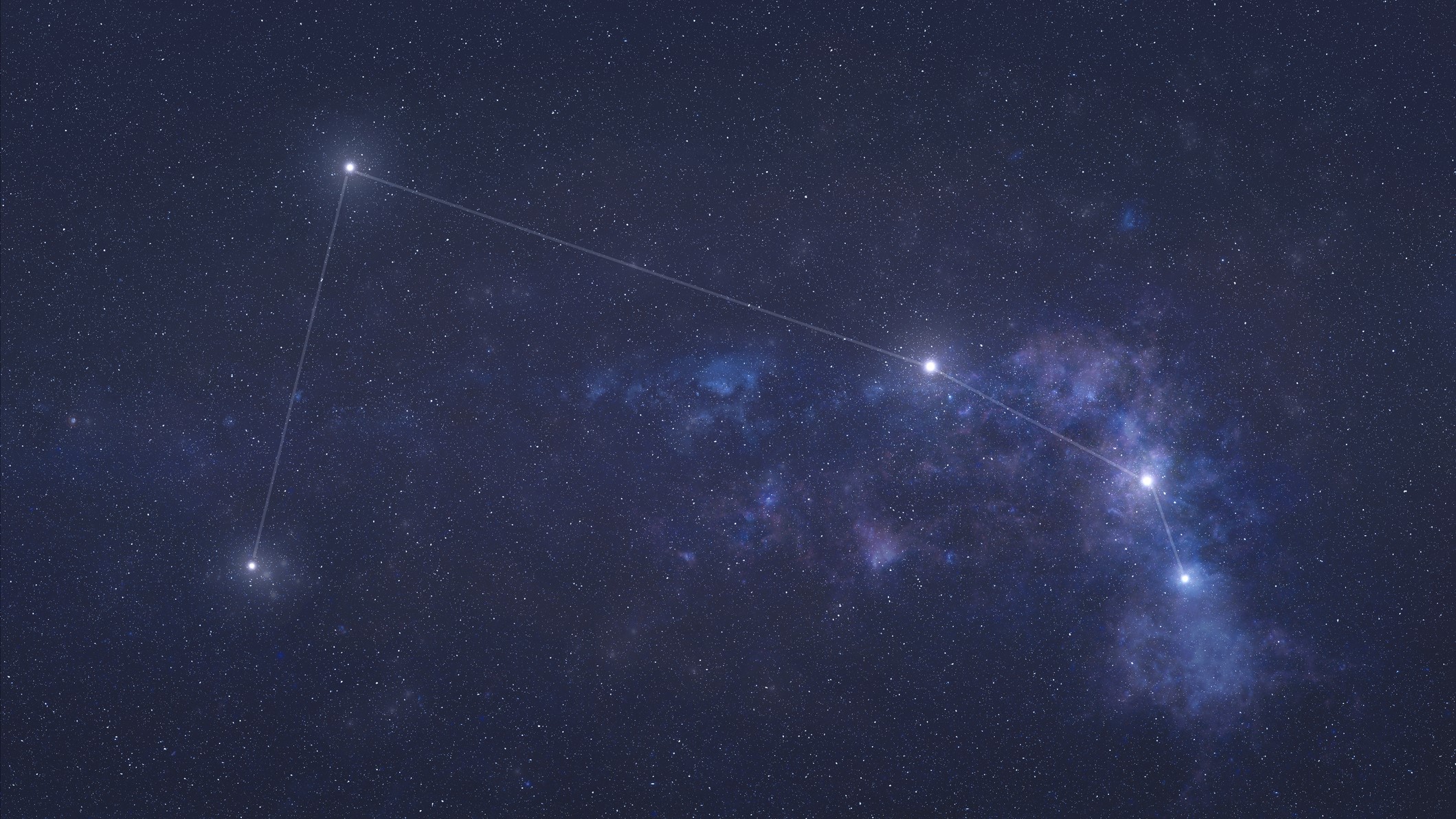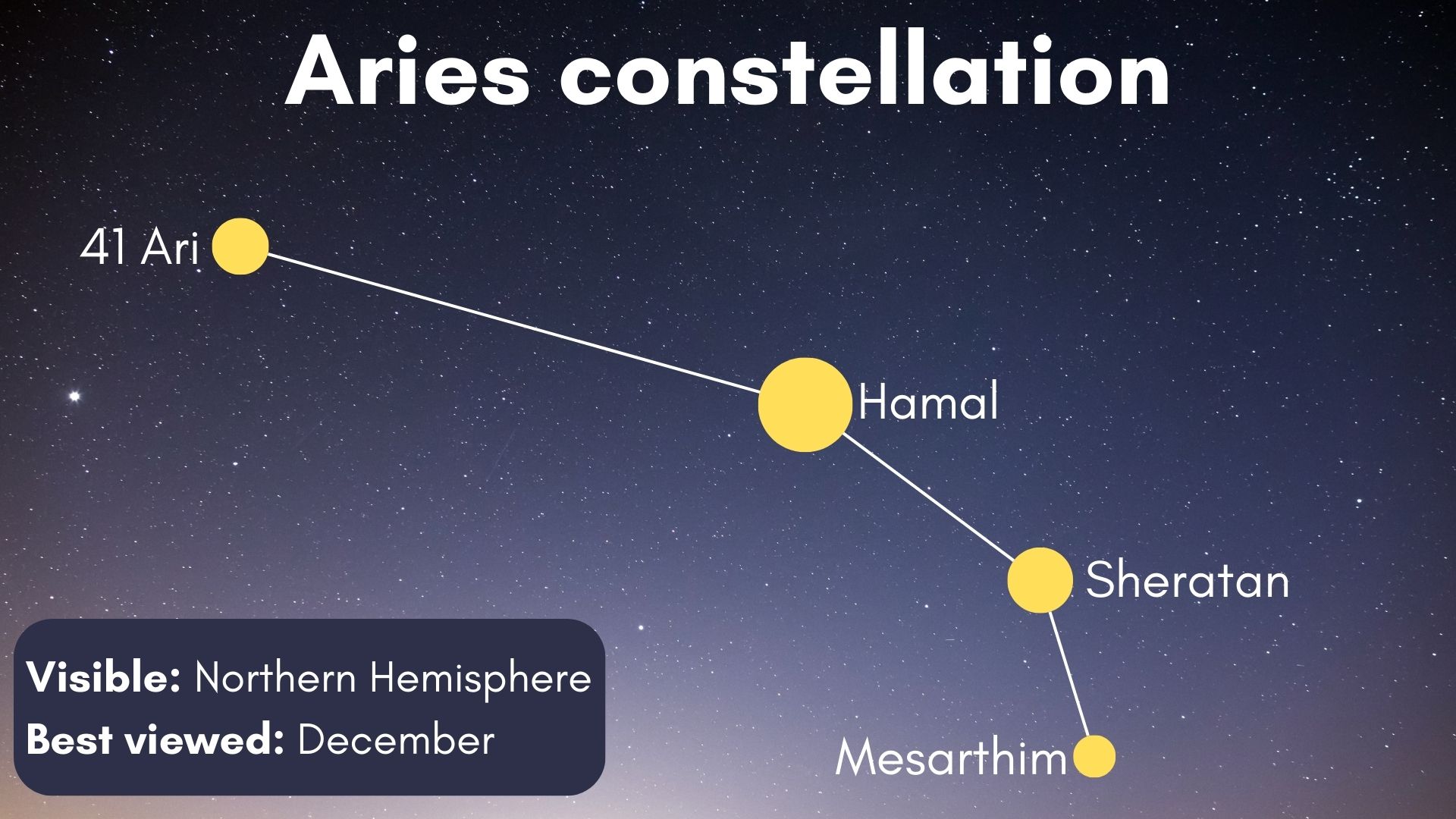Aries constellation: Facts, location and myth
The Aries constellation is a small grouping of stars in the northern sky.

Aries is an ancient constellation first listed by Ptolemy in the second century.
Though Aries is one of the 12 zodiac constellations, which are arguably some of the best known, it's the 11th smallest, taking up just 441 square degrees in the night sky. Overall, it's the 39th largest constellation, putting it in the middle of the pack of the 88 constellations recognized by the International Astronomical Union.
Aries has just six named stars, according to Constellation Guide, and most of them are quite dim, making it difficult to see this constellation from light-polluted areas of Earth. (Its brightest, Hamal, has a magnitude of 2.02.) It's also in a somewhat empty area of the sky; there are few deep-sky objects within the constellation.
Related: What's your zodiac sign? (It may not be what you think it is)
Where is Aries?
Aries can be found in the northern sky, though because its few stars are on the dimmer side, it's a bit tricky to see. The "head" of the ram is bounded by the Pleiades star cluster and the Pegasus Constellation on the east and west sides, respectively, according to EarthSky. It's best viewed from the Northern Hemisphere in December.

Aries observing targets
The constellation of Aries is in a rather quiet part of the sky, as far as deep-sky objects go. But there's always something to look at, even in the darkest parts of the night sky! If you're in the market for some stargazing equipment, check out our guides to the best telescopes and best binoculars.
Jargon buster
Magnitude: Magnitude is a measure of an object's brightness in the night sky, with lower numbers—including negative numbers— indicating a brighter object.
Right ascension (RA): Right ascension is like longitude on Earth; it's used to locate celestial objects in the sky via a measure of hours, minutes and seconds in the east-west direction.
Declination (Dec): Declination is like latitude on Earth. Through units of degrees, arcminutes and arcseconds (there are 60 arcseconds in an arcmin and 60 arcmins in a degree), declination covers the north-south direction in the sky.
Hamal
Magnitude: 2.02
Approximate distance from Earth: 66 light-years
Location: 2h 7m 10s (right ascension), +23°27'45" (declination)
Hamal is the alpha star in Aries, meaning it's the brightest in the constellation. Also referred to as Alpha Arietis, this star was an ancient equinox star, according to EarthSky; in ancient times, Hamal and the sun were in conjunction on the spring equinox. Today, they're in conjunction about a month later, on April 24.
Mesarthim
Magnitude: 4.64
Approximate distance from Earth: 164 light-years
Location: 1h 53m 31s (right ascension), +19°17'46" (declination)
Mesarthim is a triple star in Aries that's also known as Gamma Arietis, per Constellation Guide. Two of the stars are binary white A-type main sequence stars, while the third is a K-type star.
R Arietis
Magnitude: 7.3 to 13.8
Approximate distance from Earth: 4,080 light-years
Location: 2h 13m (right ascension), +24°50' (declination)
R Arietis is a variable star that changes in magnitude from 7.3 to 13.8 in just about six months, according to the Arkansas Sky Observatories.
30 Arietis
Magnitude: 6.5
Approximate distance from Earth: 190 light-years
Location: 2h 37m (right ascension), +24°38'51" (declination)
This multi-star system has two primary F-type main sequence stars, plus at least three lesser stars, including a red dwarf that was initially thought to be an exoplanet, per a 2021 paper in Astronomy & Astrophysics.
Fiddlehead Galaxy (NGC 772)

Magnitude: 10.8
Approximate distance from Earth: 130 million light-years
Location: 1h 58m 19s (right ascension), +19°00'28"' (declination)
The Fiddlehead Galaxy is a spiral galaxy with one unusually long arm, which is caused by tidal interactions with a neighboring galaxy, according to NOIRLab.
Arietid meteor shower
The Arietid meteor shower's origin point is in the constellation Aries. This annual meteor shower, runs from late May to Early July and peaks on June 7, according to spaceweather.com.
The meteor shower is unusual because it's an "invisible" one. Though it's a highly active meteor shower, you likely won't see much of it, as it peaks during daylight hours. For your best chance to see the Arietids, look at the sky in the hour before dawn during the peak, and you might spot a few shooting stars.
Mythology
Don't confuse Aries with Ares, the Greek god of war. The constellation Aries is named for the ram with the golden fleece in the Greek myth of Phrixus; "aries" is the Latin word for ram.
According to GreekMythology.com, Phrixus was the son of King Athamas of Boeotia and his first wife, the nymph Nephele. Athamas divorced Nephele to marry Ino, the daughter of the Phoenician hero Cadmus. In a jealous rage, Ino planned the demise of both Phrixus and his sister, Helle. She tricked Athamas into sacrificing Phrixus, but before Phrixus died, he was saved by a winged ram with golden fleece sent by Heracles (Hercules). Helle was also whisked away by the ram, but she fell into the sea, which was later named after her (the Hellespont, or the Dardanelles). Phrixus was carried to Colchis, where he sacrificed the ram to Zeus out of gratitude; Zeus placed the ram in the night sky to honor it, while King Aeëtes of Colchis received the ram's Golden Fleece.
Later, Jason and the Argonauts would travel to Colchis in search of the ram's golden fleece, which had been hung in a sacred grove by Aeëtes, according to PBS.
Aries constellation FAQs answered by an expert
We asked Mike Reed, an astronomer and a distinguished professor in the Department of Physics, Astronomy and Materials at Missouri State University, a few frequently asked questions about the Aries constellation.

Distinguished Professor in the Department of Physics, Astronomy and Materials at Missouri State University.
Where is the Aries constellation?
Aries is a sign of the zodiac, which means it is in the sun's path through our sky. For us in northern latitudes above the Tropic of Cancer, Aries will always appear to travel to the south of us across the sky as the Earth spins. It is a smaller constellation between the larger ones Pisces, Perseus and Taurus.
How can you find Aries?
Aries is a little bit tricky to see in the late spring. The astronomical calendar begins with the Vernal (spring) Equinox, and Aries is the first zodiacal constellation of the astronomical year. So it is fairly close to the Sun at first, though viewing it gets better each month we go into summer. As such, the best time to view it is in the early morning and this year we have some help.
During July, Aries rises around 2 a.m. and it is followed by the fourth brightest object in our sky, Jupiter (the three brightest being our Sun, the moon and then Venus.) When you find Jupiter, if you go toward overhead, the first bright star you would hit would be Hamal, which is the brightest star in Aries.
How many stars are in the Aries constellation?
Aries is not a particularly spectacular constellation, and from brighter areas, you're not likely to notice it at all. From darker locations, you will likely see four stars that fall into a crooked line, like a candy cane, facing south, that had half its handle bitten off. From really dark sites, you would see two more stars near the bottom of the cane and if you have really good eyes you could see four or five more stars in the area.
Additional resources
Watch a video about the Aries constellation by the Delta College Planetarium. Listen to a radio show about the science and mythology of Aries by WUWM 89.7. Learn more about the constellations and their symbols from NASA's Space Place.
Bibliography
Aries Constellation. Constellation Guide. Retrieved July 9, 2023, from https://www.constellation-guide.com/constellation-list/aries-constellation/
Aries Zodiac Sign - Character Traits. GreekMythology.com Retrieved July 9, 2023, from https://www.greekmythology.com/Myths/Zodiac/Aries/aries.html
Ford, D. The Constellation Aries. In the Sky. Retrieved July 9, 2023, from https://in-the-sky.org/data/constellation.php?id=8
Galaxy NGC 772. NOIRLab. Retrieved July 9, 2023, from https://noirlab.edu/public/images/noirlab2209a/
Jason and the Argonauts. PBS. Retrieved July 9, 2023, from https://www.pbs.org/mythsandheroes/myths_four_jason.html
Kiefer, F., et al., Determining the true mass of radial-velocity exoplanets with Gaia. Astronomy & Astrophysics. Retrieved July 9, 2023, from https://www.aanda.org/articles/aa/full_html/2021/01/aa39168-20/aa39168-20.html
Machholz, D. Arietids – most active daytime meteor shower – peaks June 7, 2024. EarthSky. Retrieved July 9, 2023, from https://earthsky.org/astronomy-essentials/arietids-daytime-meteor-shower-peaks/.
Meet Hamal, an ancient equinox star. EarthSky. Retrieved July 9, 2023, from https://earthsky.org/brightest-stars/hamal-ancient-equinox-star/
Sherrod, C. "GO TO"....ARIES. Arkansas Sky Observatory. Retrieved July 9, 2023, from http://arksky.org/aso-guides/aso-constellation-guides/56-aries
Join our Space Forums to keep talking space on the latest missions, night sky and more! And if you have a news tip, correction or comment, let us know at: community@space.com.
Breaking space news, the latest updates on rocket launches, skywatching events and more!

Space.com contributing writer Stefanie Waldek is a self-taught space nerd and aviation geek who is passionate about all things spaceflight and astronomy. With a background in travel and design journalism, as well as a Bachelor of Arts degree from New York University, she specializes in the budding space tourism industry and Earth-based astrotourism. In her free time, you can find her watching rocket launches or looking up at the stars, wondering what is out there. Learn more about her work at www.stefaniewaldek.com.
